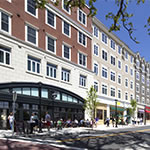Very few architects can say they built a college town from scratch; it would be the project of a lifetime. But it is an achievement Rainer Muhlbauer can safely add to his list of accomplishments. Muhlbauer is BL Companies’ director of architecture, and in 2001, the architecture, engineering, environmental, and land-surveying firm began working on what would become Storrs Center, a one-million-square-foot mixed-use village in Mansfield, Connecticut, adjacent to the University of Connecticut campus.
What it offers was missing before. “When I first moved to Connecticut, I visited the UConn campus,” Muhlbauer says. “It was totally isolated. It felt like it was in the middle of nowhere. There was no ‘there’ there. When the developer, Leyland Alliance, said they had a vision to provide a town center next to the University of Connecticut campus, we partnered with them and worked together with the city of Mansfield and UConn to make this a reality.”
It wouldn’t happen overnight. The project has taken more than 10 years, and the public-private partnership has used $25 million in taxpayer money. Phase one, completed in 2012, encompasses residential units, including approximately 290 studio, one-bedroom, two-bedroom, and three-bedroom apartments in a planned community of pedestrian walkways and green spaces.
The past two years have shown Storrs Center to be wildly successful; all retail spaces and apartments have been leased.
The 17-acre project’s sustainable attributes were mapped out early on when the design team created design guidelines based on LEED standards but customized to meet the specific objectives of Storrs Center. The goal was to make the space compact and walkable with little disturbance to natural features. All of the materials used were sourced within 500 miles, and many feature recycled content. All paints, caulking, and sealants were low or no VOC, and floor finishes were formaldehyde free.
Partner Energy, from El Segundo, California, conducted an extensive study of HVAC equipment, and as a result, the new buildings use natural-gas heating and high-efficiency cooling, as well as LED lighting. A storm-water-management system collects rainwater and distributes it to tree wells along sidewalks and newly created hiking trails.
Why people are flocking to Storrs Center is no surprise. It offers the best of both worlds: an urban feel with restaurants and shops within walking distance, as well as small-town quaintness with a picturesque setting and a focus on the natural landscape. “We wanted the area to feel like it belonged to pedestrians,” Muhlbauer says of the importance of walkability. “There’s curbside parking with meters, as well as a parking garage tucked behind the mixed-use buildings, with the idea being to promote walking and biking and leave the car behind.”
The idea that so many young people will spend some of their most formative years in what is essentially a wholly sustainable town is not lost on Muhlbauer. “Things are changing for the better,” he says. “A generation ago, sustainability wasn’t even discussed in school. Now, it’s something young people come to expect. I imagine that if Storrs Center was built without incorporating any sustainable features, there would have been much less interest and community support—and that’s not a bad thing. It’s good that there are now expectations around sustainability.”
In fact, the local community was an integral part of Storrs Center. Public meetings during the planning phase brought input from the public that was incorporated into the design. “Without the community’s involvement, this wouldn’t have been as successful,” Muhlbauer says, adding that he is proud to have taken part in something that will go down in BL Companies history as a true milestone.
“This is the kind of project all architects and engineers aspire to,” he says. “Who gets to work on something like this from scratch? I can only hope that we’ll get the opportunity to work on something like this again.”

